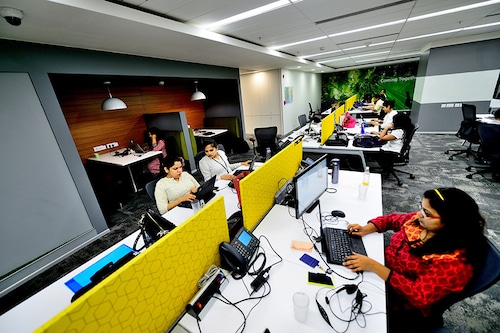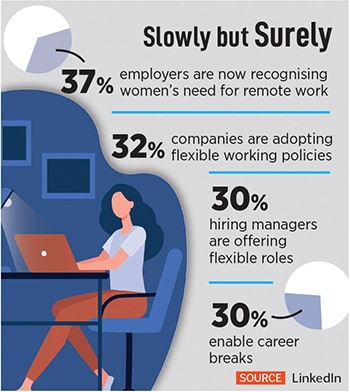The TCS annual report shows women continue to pay a price for flexibility
High attrition of women in the IT industry says a lot about the lingering ghost of gender roles and lack of flexible policies. Companies can, and must, do better


On June 6, India’s largest tech company, Tata Consultancy Services (TCS), said in its annual report that the attrition of women in its 600,000-strong workforce has been higher than men. Chief Human Resources Officer Milind Lakkad called this “unusual", given that attrition rates of women have been lower or similar to that of men. “Intuitively, I would think working from home during the pandemic reset the domestic arrangements for some women, keeping them from returning to office after everything normalised," he said in the report, which did not receive the exact attrition numbers on the basis of gender.
Women occupy 23 percent leadership positions at TCS and make up 38 percent of the company’s net hire this year. They form 35.7 percent of the workforce at TCS, falling from 36.2 percent in early 2020. Interestingly, in the case of competitor Infosys, which offers a more flexible, hybrid work policy, the proportion of women has gone up from 37.8 percent in early 2020 to 39.6 percent today. Higher attrition among women in FY23 is a setback for TCS in their efforts to promote gender diversity and inclusion, said Lakkad.
Attrition has been high across sectors despite hiring slowdown over the last three quarters, but the issue is amplified in the tech sector due to the volume of white collar talent and women in the workforce, says Kamal Karanth, co-founder of staffing firm Xpheno. He explains that the workforce in tech is comparatively more mobile and on the move in comparison to other sectors. “The IT industry still reports some of the highest attrition rates compared to other sectors. Therefore, while the trend of rising attrition is not specific to the IT industry, it definitely is higher in comparison to other sectors," he says. According to World Bank statistics, the labour force participation of women as of 2022 has been stagnant at 23 percent since the pandemic.
The IT sector has done well in terms of hiring women, if you look at the absolute numbers. Data from Xpheno says the top five IT companies have added 1.5 lakh women professionals to the tech sector since 2020, which is a 44 percent growth. The total cohort of women in the IT sector stands at 5.36 lakh in March 2023, up from 3.74 lakh in the fiscal ending March 2020. “On a net headcount basis, TCS has recorded a 35 percent growth in women workforce since FY20. The other peers in this cohort have growth figures ranging from 44 percent to as high as 64 percent during this period," says Karanth.
The problem, as it conventionally has been, is addressing the reasons why women drop out of the workforce as they rise up the career ladder, which coincides with other personal milestones like marriage, childbirth and caregiving responsibilities. In the wake of the pandemic, it also becomes important to look at how the fabric of our work culture has changed, and how it affects women more than others.
HR experts Forbes India spoke with say that while removal of flexible work arrangements affect both men and women, and the churn that IT companies are seeing is not entirely gender-specific, the reported rising attrition of women is a sign of how the transition from work from home or hybrid to full-time office is hitting this cohort first, and fast.

A 2022 consumer research survey conducted by LinkedIn among 2,266 Indian participants found that three in five working women believed the stigma around workplace flexibility is now ‘worse than ever’, with 88 percent women having had to take a pay cut to work flexibly.
“Our research reveals that due to poor flexi-working policies, India’s working women are 2x more likely to have to choose between childcare and career, when compared to men," Ruchee Anand, senior director-talent and learning solutions, LinkedIn, had told Forbes India in April 2022. Flexible working is the biggest priority for both men and women today, she added, but “the repercussions for not getting flexibility at work are far greater for women in India today".
Flexible work gave people a sense of freedom to prioritise things, and the ability to do that got disrupted when they were called back to office. Obviously, it impacts women far more because of domestic responsibilities, says Nirmala Menon, founder of CEO of Interweave Consulting, a professional diversity consulting organisation. According to her, while there is a case to be made for being in office, such as more visibility and inclusion in projects, companies not giving employees an option to choose, and imposing return to office mandates, leads to women dropping out.
“Currently, the trouble is that companies are not giving people enough time to transition," she says, explaining that for example, if there is a child at home who is used to the mother or both parents being with them through the pandemic, if parents are suddenly called into work immediately, the transition for the child is unlikely to be smooth.
Also read: Return to Office: Will women continue to pay a price for flexibility?
And in the absence of childcare services or a support system to take care of the child, it is often the mother who has to let go of her job. “The pandemic has led us to re-prioritise our lives and our goals. It has changed the way we look at work, the way we spend time with family, and the way we approach our career. Companies have to accept that reality and alter their systems according to the changing mindset," Menon says.
 In its annual report, TCS said that it has a flexible work arrangement in place, which “provides necessary support and flexibility of young children, expectant women employees, and persons with disability". For every company calling employees back to office, there is another offering remote and hybrid opportunities, says Karanth. “One-fifth of the current active white collar opportunities are full-time remote and hybrid openings."
In its annual report, TCS said that it has a flexible work arrangement in place, which “provides necessary support and flexibility of young children, expectant women employees, and persons with disability". For every company calling employees back to office, there is another offering remote and hybrid opportunities, says Karanth. “One-fifth of the current active white collar opportunities are full-time remote and hybrid openings."
The best flexible engagement going forward, according to him, will need an “employee-configurable hybrid model with tighter productivity and management processes". Work from home and hybrid, with minimal days at work are the best models of engagement that would attract and retain more women professionals in the workforce, he says.
Menon says companies have a role to play in the way they approach these challenges. This should also be through actively sensitising male employees that they need to be equal partners at home, and that domestic and care responsibilities are not a woman’s job, says Menon, adding that improvement could also reflect in terms of better paternity leave policies for men, and encouraging them to avail of those fully instead of rushing back to work. “Companies have to see the value in driving the mindset of equitable support," she says.
First Published: Jun 08, 2023, 16:54
Subscribe Now